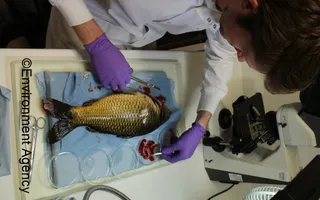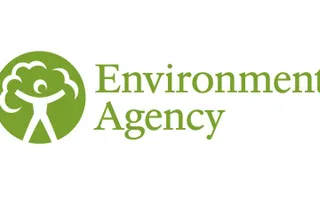Koi herpesvirus (KHV) is a virus that infects common carp (Cyprinus carpio) and its ornamental varieties, such as koi and ghost carp.
Since being first reported from Israel and the USA in 1998, KHV has spread rapidly through the international fish trade and is now one of the most significant viral diseases of carp worldwide.
KHV was first confirmed in carp fisheries in England in 2002, following mortality investigations conducted by National Fisheries Laboratory (NFL), Brampton. Despite controls, the virus has spread rapidly and is now widespread in England. To date, NFS Brampton have investigated over 120 cases of KHV, providing support and advice to help fisheries recover and avoid future outbreaks. This is a vital aspect of KHV disease as fishery management is both a trigger for the disease as well as the main route for avoiding future losses.
What does KHV do?
What triggers KHV in a fishery?
Two main factors commonly trigger KHV disease: temperature and stress. Viruses often have temperature ranges in which they become more active and pathogenic. Outbreaks of KHV generally occur in late spring and summer when water temperatures rise above 16°C. Outside of these temperatures, the virus may be less active or lie dormant without causing any signs of disease.
Increased stress is also a key factor that triggers KHV disease. This is why fishery management is so important for disease outbreaks in carp fisheries. Intensive fishery management practices, leading to poor environmental conditions, overcrowding and excessive angling pressure, can increase stress within the fish population. This reduces the immune response of carp, making them more susceptible to infections. KHV outbreaks most commonly occur in intensively managed fisheries with very high stock densities.
How is KHV spread?
Fish stocking poses the greatest risk of introducing the disease to your fishery. The difficulty is detecting the virus in healthy fish, as carp may carry the virus without showing signs of disease. Current surveillance efforts for KHV are based only on KHV disease, not the virus itself, so there is a risk that KHV can spread undetected. It is also possible to transfer the virus on wet fishing tackle, nets and boots, or by the transfer of infected water. Good fishery management and biosecurity are therefore critical in minimising the risk of transferring KHV into your fishery.
How is KHV confirmed?
If necessary, a fish disease investigation may be conducted at the Environment Agency's fish disease laboratory. This includes comprehensive testing for parasites, bacteria, fungi and viruses including KHV, as well as assessments of fishery management practices and environmental conditions.
KHV is a notifiable disease and it is a legal requirement to notify the government's Fish Health Inspectorate (FHI) upon suspicion of any notifiable disease. We have a legal duty to tell the FHI immediately if we suspect KHV during our mortality investigations and we work closely with the FHI to protect our fisheries from important diseases.
KHV controls
Since the detection of KHV in carp fisheries in 2002, control measures have been in place to limit the spread of the virus in England. These were initially placed by the Environment Agency under Section 30 of the Salmon and Freshwater Fisheries Act, 1975. This involved movement restrictions on all waters where the virus was confirmed.
In 2007, KHV became a notifiable disease under the Aquatic Animal Health (England and Wales) Regulations. This made it a legal obligation to report suspicion of the disease in any farmed or wild fish to the FHI. We support fisheries with KHV by providing fishery management advice and guidance, to understand the reasons for the outbreak and what can be done to avoid problems arising again in the future.
What can I do to reduce the risks of KHV disease in my fishery?
As most KHV outbreaks are triggered by either environmental conditions or intensive fishery management, there are many things that can be done to limit losses and prevent a re-occurrence of disease.
-
Have a fishery plan and seek advice. Understand what sort of fishery you are trying to develop, discuss this with your local fishery officer or professional and don't take shortcuts.
-
Ensure good biosecurity is followed. This includes disinfection and drying practices, and awareness of disease risks from fish stocking, anglers' equipment and vehicles.
-
Sensible stocking and stock levels. Stocking fish represents the greatest risk of disease transfer, so always seek advice before stocking, stock from reputable sources, and get fish health checked. High stock densities are also a risk factor for KHV disease, with overstocking increasing stress and competition for food and habitat.
-
Keep stress levels to a minimum. Stress is a key trigger for many diseases including KHV. This can be minimised through good fishery management practices and ensuring good water quality, habitat and nutrition.
-
Monitoring fish health and fishery performance. Keep a close eye on the health of fish and how a fishery is performing. This is particularly important during spring and summer, where diseases like KHV are most active. Ageing surveys can provide a valuable understanding of fish growth and fishery performance. If in doubt, seek advice.
-
Report losses or disease problems immediately. Report any signs of ill health, disease or mortality to the Environment
Agency incident hotline (0800 80 70 60) or your local fishery officer immediately. If KHV is suspected, the Environment Agency will automatically notify the FHI as part of their wider mortality investigations.
If you experience fish disease problems, or you would like more information about these conditions, please contact: National Fisheries Services, Environment Agency, Bromholme Lane, Brampton, Huntingdon, PE28 4NE.
Call: 02084 745244 / team mobile: 07768 022726
Email: [email protected].
Further information can be found on the EA's KHV factsheets.









